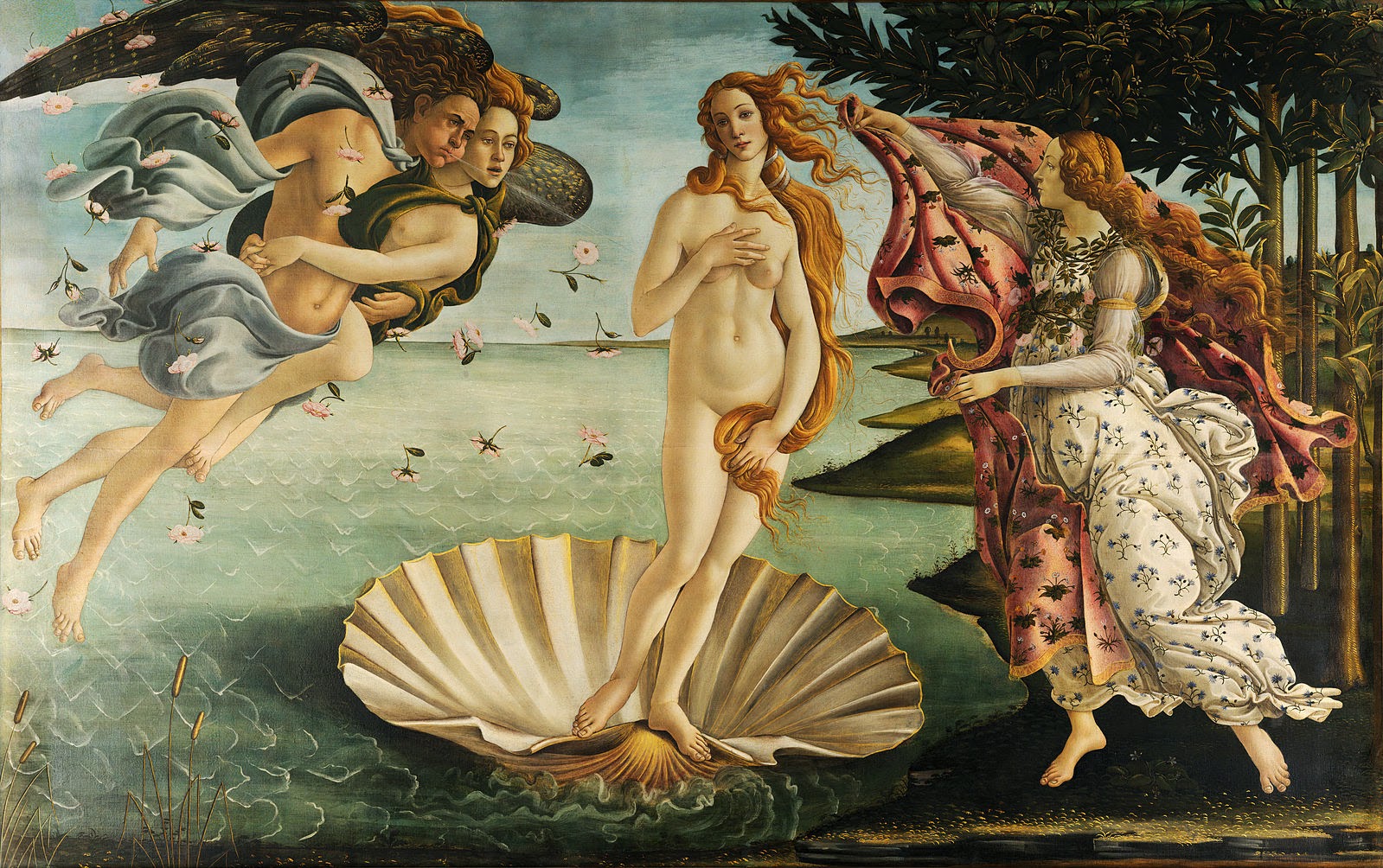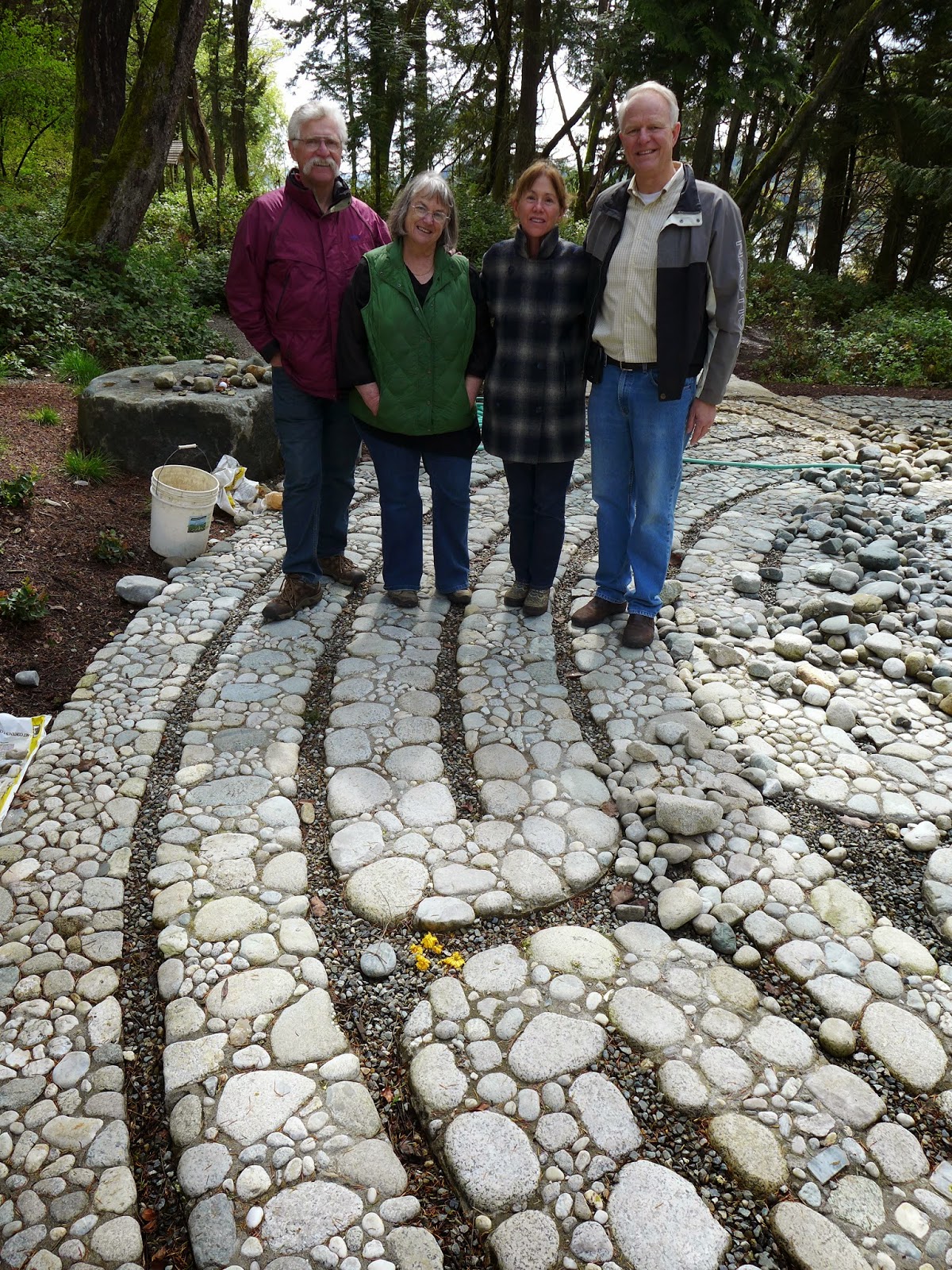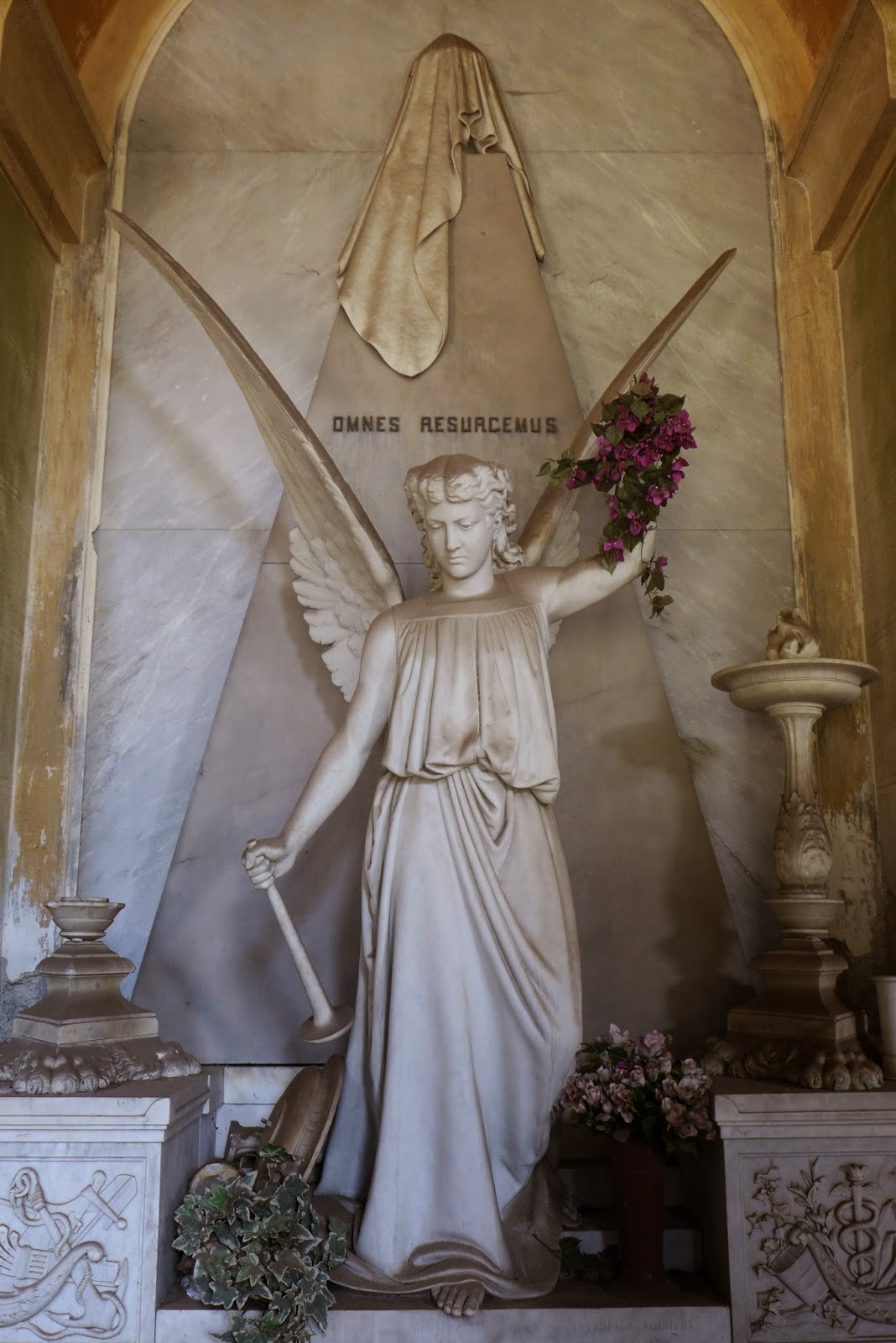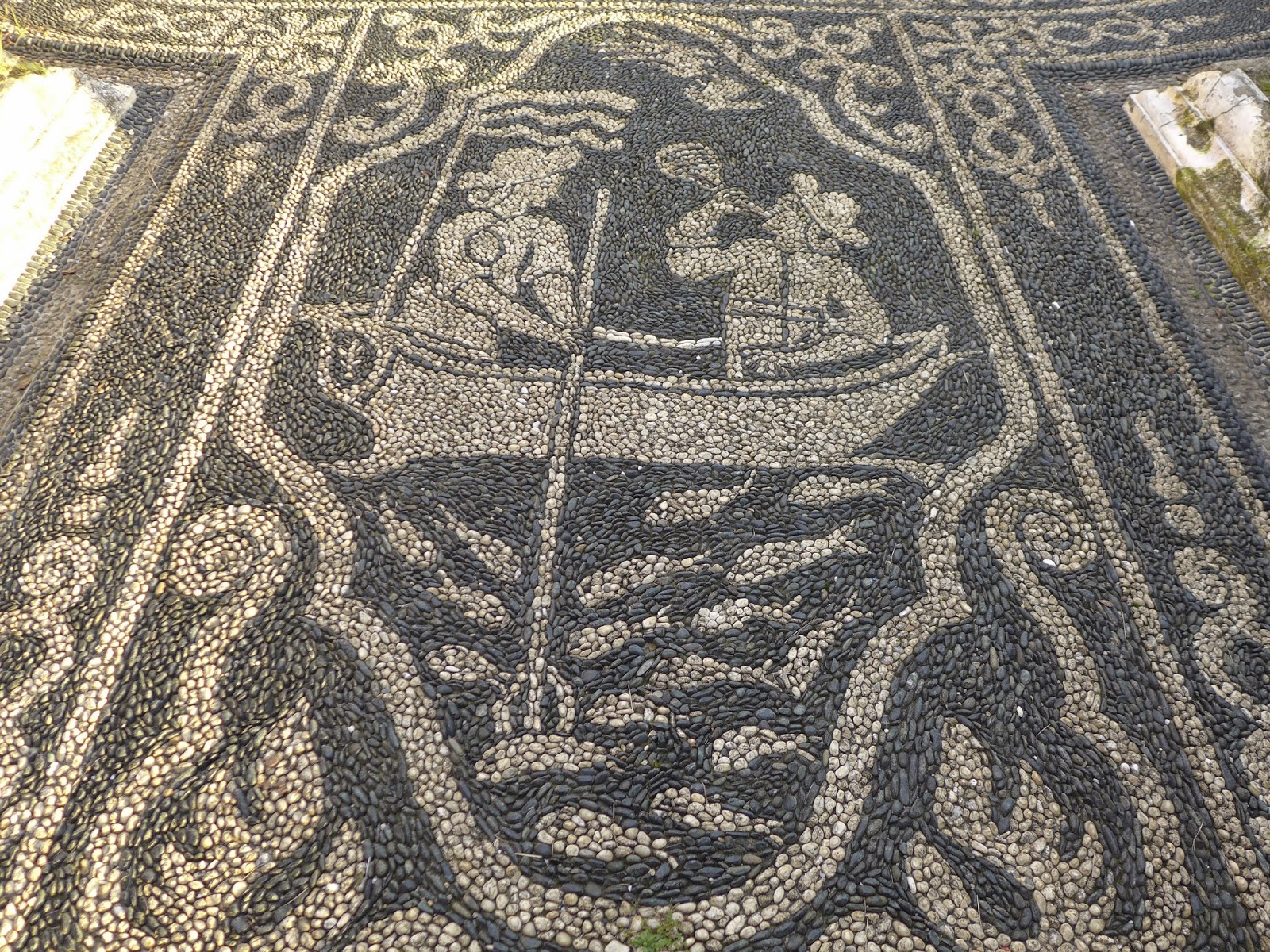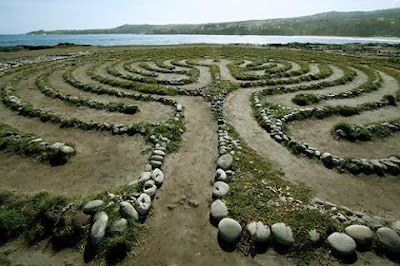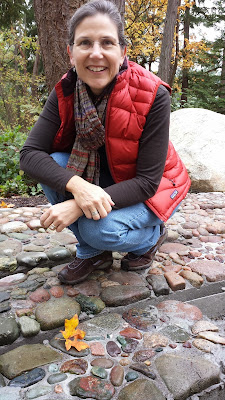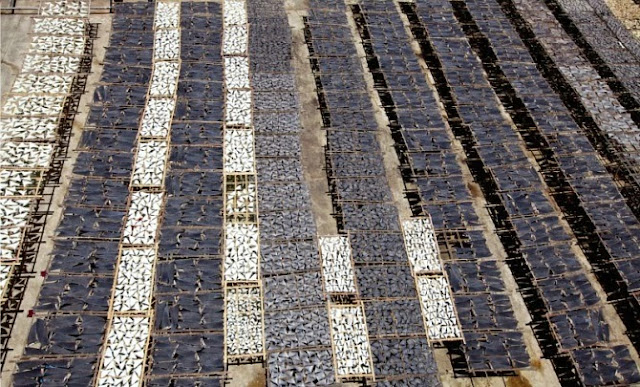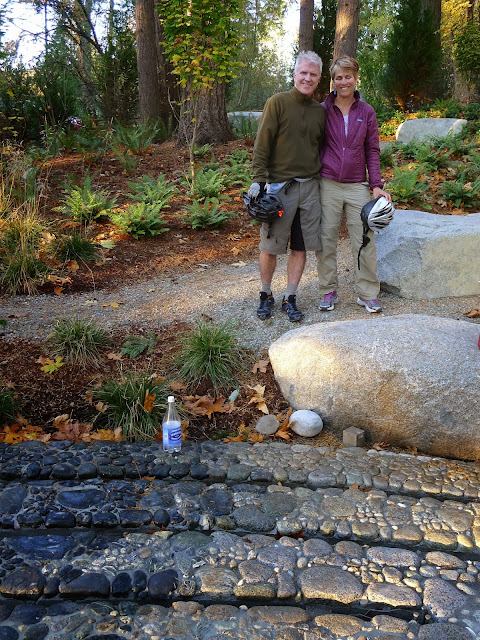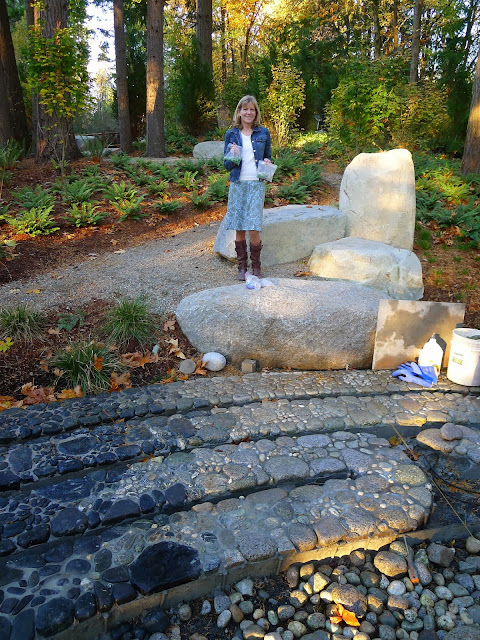This is the second essay about the Halls Hill Labyrinth Project. If you haven't read the first, scroll down past this one and you will find the first one. Thanks, Jeffrey
"If we really wished, if we actually dared to devise a style of architecture which corresponded to the state of our souls, a labyrinth would be the building we should erect. But we are too cowardly to construct anything which would be such a complete revelation of our hearts." Nietzsche
I guess I'm taking the dare.
A gardening friend of mine, Diana Goings sent me a picture of the beautiful labyrinth at the Shrine of Saint Therese outside of Juneau, Alaska. The paths are lined with stones gathered from the beach, encircled by a lush border of sheltering shrubs.
![]() |
| The Labyrinth at the Shrine of St. Therese in Juneau, Alaska Photo by Diana Goings |
While looking at the website for the Shrine I came across this video called Labyrinths through the ages:
It gives a visual history of labyrinths from many parts of the world created over a span of thousands of years. I've been fantasizing about having some of the petroglyphs shown in this video carved in to the granite boulders that mark the cardinal points.
I went home for 4 days to rest my body, a 4 1/2 hour drive. I traded massage with two friends an hour after I arrived home. Its something I have been doing for 28 years with my dear friend Evelyn and a number of third persons, who at present is a recent devotee named Holcombe. 2 on 1 massage is the best massage ever. We pull and twist and roll your body in to a variety of positions to expose muscles and lengthen the spine and limbs. I got another one two days later from my friend Mikey who has recently completed his certification as a massage therapist. Both massages were brutal and deep and reparative. I love the waves of endorphins that kick in after a painful grinding with an elbow under my scapulas. Massage basically heals you proactively and immediately. Most people rarely or never get them. This baffles me because it is always the highlight of my week. Because we trade it is free, and we have developed a pantheon of wonderful techniques derived directly from experience. All three of us get a great massage. Mikey said he put his foot on the wall for leverage as he ground in to my back. If I could get one of these every day I would. If I didn't do it weekly I doubt I would be able to continue to be a stone mason.
I lead what many believe to be a very good life, in large part because I make a point of traveling every winter. With miles I earned buying materials I've gotten round trips to Rome, Istanbul, and Barcelona for a couple hundred dollars each. This fall I got one to Athens, stopping in Paris again for a week. Yippee!
![]() |
| Graffiti in Paris |
My plan is to visit Chartes Cathedral near Paris to see the labyrinth that I am basing the one I'm building on. I have read that it is usually covered with pews so it is only walkable in the summer. Oh well, I am going anyway. A week later I will fly to Athens and spend the winter exploring islands. I hope to rent a small place on Santorini and explore Rhodes. I also want to spend time in Crete and visit Knossos, where the Labyrinth that once held the Minotaur captive was said to have been built. Who knows what will actually happen but I have 3 months to explore. Then I will return and finish this project, hopefully in conjunction with the Spring Equinox.
![]() |
| Visting the Acropolis in Athens 4 years ago |
It poured rain but occasionally the sun found its way through the clouds on my way back to the island. My spirit is greatly boosted by those sun breaks. It was raining hard when I pulled off to the beach at Purdy north of the Tacoma Narrows Bridge, but there was a patch of blue sky positioned to pass over soon so I stopped and gathered four buckets of stones from this beach that I have picked from for years. The tide was in so I put on my 'Brit Middies' (they are really called that) made by Muck Boots, my favorite garden work footwear. This enabled me to step in to the water, but had to dodge little waves or get a shoe full. I had 2 buckets of rock by the time the next squall hit and I drove to Bainbridge. The sun was out again there and everything was washed down and vibrant. They had had 5 inches of rain over the weekend while I was home.
![]() |
| Seattle across the water, with a Monet sky |
I drove to the site and unloaded my rock, washed them, and sorted the colors I will need for the upcoming week, silver and blue green and yellow. I will then have nearly completed the outside ring. That should happen in the next couple of days. There is a full pallet of mortar and 200 feet of steel rebar waiting for me. I put up my shade structure frame to be prepared for rain. I also brought better rain gear and glove liners this time. I was thrown a little when I found that all the saw cut stones I had found on the beach were gone from the center altar, along with some metal pieces and shells. It seems like a strange place to pilfer things, but I am sure I will find more and passed it off as another sign of duality in the universe.
When I got up in the morning it was pouring rain, monsoon style. I wanted to go back to bed, but by the time I was finished with breakfast the rain had stopped and I was blessed with a dry day. Whenever the sun broke through the clouds the temperature went up a little and my mood elevated. The skies have been so beautiful.
![]() |
| A break in the weather |
I started by gathering four buckets of rock from Rockaway Beach as the tide was out. Then I went to the site and spent the entire afternoon setting the Rest and Cleansing Moon (Jan. 20 to Feb. 18), which is flanked by silver stones. I used artistic license on this one. The mix of stones gives the appearance to me to me of shades of silver. The totem mineral for this moon is silver as well. The animal here is the otter, both fresh water and sea otters, which I've heard visit the shores of Bainbridge Island. Sea otters were driven to near extinction by fur trappers at the beginning of the 20th Century. The plant for this moon is Quaking Aspen, which have silvery bark. This would be the Aquarian Moon.
![]() |
| The Rest and Cleansing Moon |
From there silver transitions in to blue green stones for the Big Winds Moon. I was able to find enough in this color range to make it read as such. Turquoise is the mineral here. The cougar is the animal, and plantain is the totem plant. This would be the Pisces Moon. From here I am beginning to transition in to the color yellow. I've been collecting yellowish stones, iron stained granite, quartzite, and sandstone that I will mix together at the entrance to the labyrinth.
![]() |
| The Big Winds Moon |
![]() |
| I started just past the boulder in the middle today...good progress |
![]() |
| The 11th Circuit is nearly complete |
I had an hour of light left so I ran over to Rockaway Beach and filled four buckets of stones. I am starting to look for larger oval stones to make a 108 stone mandala in the 10th ring. That is 27 stones in each quarter, nine stones for each moon. The paths will make their first turns to link to the 10th circuit.
![]() |
| Sunset on Rockaway Beach |
In the morning I returned to the Rockaway Beach, to a boat ramp at a house I was given permission to use. This makes it a shorter schlep for carrying buckets of rock from the middle of the beach. I focused on larger sizes of stones for framing the paths, and looked for large ovals to use as Mala stones. This can be exhausting work and my arms ache after 4 hours of picking.
I later worked until dark setting the eastern 'Budding Trees Moon', where the outer ring path turns towards the center. The color for this moon is yellow, which took a lot of searching to come up with enough stones in this color range to do the work. The mineral for this moon is the Fire Opal, the animal is the Red-tailed Hawk, and the plant, the dandelion. This is the Aries Moon of the Spring Equinox.
My project manager Gregory came by for a visit, and afterwards he went to use the prayer wheel to send a much needed intention out in to the world. I made a big yellow flower for him in the turn in the path, the first of the 108 large stones that will be set in the 10th circuit.
![]() |
| Gregory's flower, the first or last Mala stone |
The next day he took me to a house down the beach where the owners have graciously offered to let me collect rock where they have access to the shore line. There are larger stones in this section and I was able to gather over 1,000 pounds before the tide came in. Sorry body, I push you so hard.
I unloaded and washed and sorted the rock to the various color piles. The site is getting a little messy as I bring in more and more rock, but I need to spread them out to see what I have. I finished setting up the forms for the entry and a 180 degree turn in the outer ring.
![]() |
| The Budding Trees Moon at a turn in the path |
My friend Jan Hilmer, an artist who lives and works in L.A. and New York, and Bali in the winter came to visit on his way to do some creative wood carving with a friend up on Orcas Island. He is an inspired and talented man in many mediums. It was fun to share this project with him. The park had been pretty quiet since my return but the sun came out and a steady stream of people passed through while we visited making it seem a busy place.
![]() |
| A friend comes to visit |
I slept in the next morning and did a lot of stretching and self massage to get the body rolling for another day. There was a blanket of fog obscuring the view of Seattle, but the most romantic dream like image of a schooner with white sails was just visible like a ghost in the mists offshore.
![]() |
| The morning view |
I went to the site and started working on the entry to the labyrinth as the fog burned off. The entry is in the east and adjacent to the Budding Trees Moon so I used more yellow stones. A really nice guy named Chip came to check out the work and stayed for some time talking about the project. I told him about my habit of making flowers when people turn the prayer wheel and he told me he would do it for his cousin, who had just been diagnosed with stage 3 pancreatic cancer. So I made her a flower at the very beginning of where you enter the labyrinth, a healing flower filled with compassion and positive but pensive energy. Good health is a treasure that should not be taken for granted. But then mortality can be the greatest teacher, and the labyrinth is in many ways a path of life and its dual opposite, death and transformation. At a lecture I attended years ago by the Dalai Lama in Bodhgaya, India (the place where the Buddha attained enlightenment), he made the impressionable statement that Death is the most important thing you can prepare for in life as it will be the most important transition we will make. I use this ideal to motivate me as I navigate the path of life. Make the most of each day.
![]() |
| Chip blessing the flower made for his cousin |
As I place the 108 stones in the 10th circuit I've been explaining to people some of the meanings behind this number. There are 108 Mala beads in a Hindu or Buddhist prayer bracelet used for counting while chanting or reciting a mantra. This could make for a very slow circumambulation of the 10th circuit if you are to express something on each of the stones as you walk the path. There is potential for great focus, transformation, and healing if a person were to fully actualize this practice with a conscious intention in mind.
The diameter of this labyrinth is 36 feet, which when multiplied by 3 is 108. There are 9 Mala stones between each of the 12 moons and 27 in each quarter of the circuit. The individual digits of 108 represent 1, an individual thing or self, 0, nothing, and 8, the symbol for infinity. 54 stones will be set on each side of the axis to the right of the entrance. This for me represents the force of duality in constant flux to maintain the balance that regulates the cosmos.
In Hindu mythology, the creation of the cosmos is sometimes described as a story called the Churning of the Sea of Milk. This is a cosmic tug of war between the two opposites of all things pushing and pulling on each other to create motion. Devas (demi Gods) and Asuras (Demons) pull back and forth on Vasuki, a seven headed Naga Cobra and the king of serpents. Vasuki is wrapped around the holy Mount Meru, which is used to churn the Sea or Ocean of Milk to create Amrit, the elixir of immortality that had been lost to the Gods. The God Vishnu directs the proceedings in two incarnations, one as a turtle, Kurma, who supports the mountain to prevent it from sinking. In the other he sits on top of the mountain and inspires the churning. In the duality of the process, a powerful poison is produced, perhaps to balance the Amrita. Lord Shiva is said to have drank the poison in order to save the universe, turning his neck blue. One of the gifts produced in the churning was the Moon.
![]() |
| Angkor Wat in the 1990's |
At Angkor Wat in Cambodia, the entire temple complex is a giant model of this concept. The vast surrounding moat is the Sea of Milk. The railings surrounding all of the terraces are the Vasuki like Naga serpents. The central tower of the temple is Mt. Meru, the churn. I have visited Angkor twice, spending nearly a month all together exploring the ruins. This is by far the most profound architectural complex I have ever visited. Everything has a reason and is inextricably connected to the greater universe in time and space. The stories are laid out in vast exquisite bas reliefs, the greatest being 'The Churning of the Sea of Milk'.
![]() |
| Bas relief of the Churning of the Sea of Milk at Angkor Wat |
I am borrowing some of these ideas and alluding to sacred stories to incorporate in to the labyrinth, that it might attract divine energy.
![]() |
| My first attempt at a turn in the path from the 11th to the 10th circuit |
Krishna, the Blue God and eighth incarnation of Vishnu in the Hindu religion has 108 Gopis or devoted milk maids who danced a circular dance called the 'Rasa Lila'. This dance is considered to be transcendent of time. To walk the labyrinth as a dance, contemplating the 108 stones in the 10th circuit, the lunar cycles in the 11th, the orbit of the 8 known planets around the sun in the inner 8 circuits, and the seasonal changes that occur as the Earth circumambulates the sun in all of the circuits has the potential to connect the labyrinth walker to the greater universe, and the divine consciousness represented by the spirit of Krishna.
![]() |
| An embroidered depiction of the Rasa Lila |
Finding the right stones for this purpose has required a lot of searching for larger oval stones with a wide flat surface in the right colors. It seems to be another kind of penance. It is a great endeavor to seek out all the stone I need to continue building the paths. At this point I've gathered well over 4 tons.
![]() |
| Larger stones create a Mala bead bracelet of 108 stones in the 10th circuit of the labyrinth |
The weather has become lovely again and I am pushing to make as much progress as possible while it is pleasant out. I dread the cold rainy days that probably lie ahead. The sunshine and the weekend brought out a lot of visitors to the park, and I've had some very engaging conversations. Making the flowers has made the labyrinth personal for a number of people who seem to be truly enchanted by the space that is taking shape. A lovely couple named Brian and Shelley came by in the afternoon on Saturday.
![]() |
| Brian and Shelly |
I made them a beautiful flower when they rang the prayer wheel, between the 21 and 22nd Mala stones so they could find it later. By counting the stones they can become a kind of address.
![]() |
| Bryan and Shelly's flower |
As we were talking the Douglas Squirrel that lives in the surrounding trees came out and ran around on the path, not far from where we were standing. They are adorable little brown chattering characters, who live primarily on the seeds in the cones of conifers. I told Brian and Shelley about seeing a Bald Eagle, and finding the feather, and the deer that came the day I made the Corn Planting Moon, and the frogs that croak in the direction of the Frogs Return Moon. I explained that the labyrinth is permeable, so that and water can soak in to the Earth and life can blend in to the gaps between the paths.
![]() |
| In perspective the half farther away looks so much smaller than the closer half |
Sunday was warm and sunny, and couples, some with young children came by to check out the progress. Everybody wants to know when it will be finished. Sometime next Spring. I want to incorporate the Spring Equinox in to the paths and perhaps manifest a Summer Solstice walk. I've been working in the Summer moons part of the 10th circuit from the south to the west today, using up much of the red and purple I've gathered. Its harder to make nice flowers because the space between the Mala stones is restricted.
Today, October 6th was my Mother's 80th birthday, and she had asked me if I would make a flower for her. I want it to be very special, and so I decided I would make the last moon in the 11th circuit, the Ducks Fly Moon that lies in the gap between the turns on the western side of the labyrinth, the point of the autumnal equinox, in her honor. We were both born under this Libra Moon. I had to return to the beach to collect more purple stones and find more Mala stones. There are 9 between each moon passing through the range of colors in the Medicine Wheel. Large oval purple stones are hard to find. I also need brown, orange, black, white, silver, blue green, and yellow Mala stones to finish this circuit. I have about 60 more to set before the paths turn to the 9th circuit. I worked until dark and wasn't able to make a suitable flower for my Mother, or reach the point where I could create the moon, which was frustrating. When I called her that night I promised that I would do the work soon. Her favorite color is turquoise blue, so I would like to make her a splendid flower when I get to the blue green part of the color wheel around the big winds moon. But I will make a sprinkling of flowers thinking of her throughout the entire project.
![]() |
| My Mother feeding a peacock at Peterson's Rock Garden in the early 50's |
The following morning I was fortunate to have dry weather again and was able to finish the first half of the 10th circuit, connecting a turn from the outer ring on the western side of the labyrinth. My body is feeling run down and exhausted, and I haven't been sleeping well as I think about the project all the time. I had planned to take the afternoon off but ended up at the beach collecting another 500 pounds of rock so that I can continue my way around through the Autumn months with the colors of brown, orange, black, and white. I have found most of the Mala stones for these colors but would like to find some with transitional blends of colors. I've only found a few silver and blue green stones that will work for those areas so I will need to do an intensive search for those once I make my way around the circuit.
After I rolled the buckets of stone down the hill in my wheel barrow, and washed and sorted them to the areas they will be set, I sat and did a series of chants to clear my mind and ground myself. I feel like a mosaic machine when I am working in full mode and need to reclaim the joy of the work. I love seeing the progress but the exhaustion dampens my mood. So I went down the to Prayer Wheel, which I haven't done since I started and sent out three different intentions, including the wish that I survive the process of manifesting this project. The circuits get considerably smaller as I move inward. The first two are a substantial percentage of the entire project (I'm saying that to comfort myself).
It was getting dark, but I sat on the swinging bench for a while and stared at the bay. This is such a beautiful place.
![]() |
| The view from the swing |
October 8: It poured rain this morning and there were flashes of lightning and thunder, so I procrastinated getting myself to the site until the rain let up. I removed yesterday's forms and set up the next area. I only had a bag and a half of mortar left so I mixed those and made the second turn at the western cardinal point. I was fantasizing taking a break from the project when the new pallet of 80 pound bags of mortar arrived. So I pushed onward. After mixing two bags and spreading them in the form it started to pour rain. I grabbed a tarp and crawled under it using my head as a tent pole. I have a structure set up to attach the tarp to but it is on the other side of the labyrinth and is hard to move by myself. Halfway through setting the stones the rain let up and I was able to emerge from under cover. It was sort of funny and sort of not. For some reason whenever I am wet and I set the hose down the spray nozzle goes off and soaks me. This has been happening for years. A jet of water shot up my pant leg, and profanities rang out. I'm glad nobody was around.
![]() |
| Laying out orange Mani Stones in the 10th circuit |
Now there was blue sky so I continued to work. A gardener who does maintenance down the hill came by to visit. He does stone masonry himself, and we talked for a long time about the local beach rock and various projects. I love using stone collected from these beaches. The colors are so varied and rich, and many of the pieces I'm using are absolutely gorgeous. I worked my way through the brown and orange sections of the Medicine Wheel and transitioned in to black, mixing in stones that have orange and black veins or spots.
![]() |
| Luke stopping by for a visit |
I ran down to the beach at dusk as I need more black and white stones to carry on tomorrow. The tide was in so I had to dodge waves. In the end I took off my pants and waded out in to the water in my undershorts to access the pieces that were calling to me in the rising tide. I cant imagine how many stones this project will take. The sunset over Seattle from the water was grandiose with thunderheads heading for the Cascade Range.
![]() |
| A gorgeous late afternoon sky |
October 10: This morning when I started work I made two small white flowers, dedicated to two people, Jadin and Joe Bell, using mortar mixed with a copious amount of tears. I had read a news story before leaving for work that Joe Bell, a man who was walking cross country as a way to deal with his grief after his son had committed suicide from incessant bullying in high school, had been struck and killed by a semi truck. They were from La Grande, Oregon a small town in the eastern part of the state. Joe Bell's journey was one inspired by the desire to speak in the towns he passed through about the need to end the bullying that is all too common in our public schools, especially directed at young people who might be different. His walk was a kind of penance strong enough to address his tragic loss. Here is a link to a story in the Denver Post, and a beautifully written article by Pauls Toutonghi published in September for Salon.com a month before Joe's death.
http://www.denverpost.com/breakingnews/ci_24282181/man-walking-memorialize-his-son-is-fatally-hit
http://www.salon.com/2013/09/08/“they_ripped_him_apart”_searching_for_answers_in_the_suicide_of_bullied_teen_jadin_bell/
![]() |
| Two white flowers dedicated to Jadin and Joe Bell, on either side of the 79th Mala Stones |
The flowers are white and in the northerly direction on either side of the 79th Mala Stone, near the Earth Renewal or Capricorn Moon. It is my hope that these two small flowers will emit a feeling of acceptance, understanding, loving compassion and strength to all who pass over them while walking the labyrinth. They are for me a pledge to be a kinder person.
The sign was delivered today that describes the project so that people who visit will have a better understanding of what it is that I am building here. Gregory will mount it on posts to the side of the entrance to the labyrinth.
![]() |
| A sign describing the Halls Hill Labyrinth Project |
I had a great meeting with people involved in the project who suggested the idea of making a 'Community Circuit' using stones given to me by people who would like to contribute something to the project. So I will make a sign to post describing what I am looking for in terms of shape, size, and color and provide a place for people to drop them off if I am not there. For a description of the kinds of stones I use; they should be somewhat like blocks, squarish in profile, with a flat top and ideally 90 degree sides so that they fit tightly together and are comfortable to walk on.
When selecting stones it is good to look at them from the side, turning them to find the plane that would be the top, ones that don't have bumps on the sides that would make them difficult to fit tightly together with other stones.
![]() |
| An ideally shaped stone, with a nice flat top and square sides |
![]()
A good way to test them is to put two possibilities together to see how they look. They can be small or large but should be at least 2 inches thick in the direction that will be imbedded in to the mortar so they wont pop out later. Thin pancake like stones have the tendency to become dislodged over time, which I really don't want to have happen. I'll use the stones you bring me in the mosaic if they pass those requirements. These will probably go in to the 3rd circuit from the center, which will represent the planet Earth orbiting the Sun. I will be building this circuit next Spring. If you do bring stones to the site and I am not there you can leave them next to the sign.
I also finished the 12th moon in the outer circuit, the 'Ducks Fly Moon' which is the moon for the sign of Libra which my Mother and I were born under. It lies in the western direction between the two turns in the outer ring. I dedicated this moon to my Mother and I call it the Mary Lou Moon.
![]() |
| The Ducks Fly Moon, dedicated to my Mother Mary Louise in honor of her 80th birthday |
As usual I needed more stones to continue the Mala circuit. So I went to the house at the far end of Rockaway Beach where I was given permission to collect rock because there are larger sizes of stones there and I hadn't been to that section of the beach for a while. I think I found what I needed and worked until dark continuing along my way setting stones in mortar.
I didn't sleep well again, probably because I my body is so sore and my mind if full of rocks, but I had a very productive day. As the project progresses and I meet more people, the Labyrinth seems to become more meaningful and profound with each passing day. There is a strong sense of gratitude from the people who visit this park as it is a place of beauty, solace and peace. When I describe the meaning of various parts of the design and how the labyrinth could be used it resonates with the richness of possibility and generates a lot of excitement for visitors.
Gregory was at the site when I arrived today, installing the sign for the project. It is perfectly placed. I love how conscious every element of this project is. It is a pleasure to work on such a level.
![]() |
| Gregory installs the sign |
My friends Terry Moyemont and Terri Stanley came to visit today and shoot some video in the afternoon. They live up in Kingston and specialize in Mediterranean plants. It was great to see and spend time with them again. We talked about travel, and Greece, where I will be spending the winter. They have a long history and connection to that ancient country. They are truly kindred spirits, bringing to my attention a number of people and works of literature that I would like to know in regards to this project and life in general. Terry recently had his second hip surgery and is regaining his mobility. I made them each a flower as I entered the blue green realm of the Strong Winds Moon. The colors of these stones are so pretty. Some of the individual stones are works of art on their own.
Nancy and Dave came along just as the Terryi's were leaving. Dan is blind and Nancy brought him over to feel some of the stones I am working with, and the texture of the mosaics. I made them each a flower on either side of a gorgeous piece that looks like a blue heart, with dark blue veins.
![]() |
| Nancy and Dan's flowers and the 'Blue Heart' Mala stone |
Nancy's radiant smile and the sweetness of their visit will stay with me for some time, and may those who pass over this spot when walking the labyrinth feel some of the joy inspired during our visit.
![]() |
| Dave and Nancy visiting the site |
Another couple from the island came by after that and again were very excited about what is manifesting here. Its gratifying to be working on something that can mean so much to people. For years I have built beautiful gardens and works in stone but they have mostly been private.
![]() |
| Happy Visitors |
I worked until dark and brought the 10th circuit to where it will bend and parallel the entry path. This part of the path is centered on the East West axis along with the one leading in to the circle in the center, which will be the sun, with a moon in its center. This 13th Moon in the center will represent the Blue Moon, and solar and lunar eclipses. The eight circuits leading out from the sun will be the paths of the known planets, Mercury, Venus, Earth, Mars, Jupiter, Saturn, Uranus, and Neptune. Pluto will be interspersed in to the 9th circuit between the four elements, in reference to the Greek God of the Underworld. There is an excellent explanation of who Pluto represents at: http://en.wikipedia.org/wiki/Pluto_(mythology) Pluto in the 9th ring represents the riches and fertility of the Earth that lies beneath its surface. Pluto, a God of the Underworld was a benevolent form and caretaker in the afterlife. Wedded with Persephone, who reemerges in the Spring from beneath the soil, when the Earth is awakens from the darkness of winter. Pluto and Persephone symbolize the guardians who care for those who have passed and gone back in to the fold.
![]() |
| The Planets in our Solar System |
I finished the 10th circuit just as it got dark, except for the turns in the path that I will connect when I build the 9th circuit. I'll add the 108th Mala stone when I construct the turn at the end of this circuit. I've been working on each ring in a Sun wise direction. I will begin the 9th circuit on the other side of the entry path next.
![]() |
| Reaching the turn at the end of the 10th circuit |
In the morning I removed the steel forms from yesterday's work. I do this very carefully so as not to loosen any of the stones along the edge. But today one came out. So I used my screw driver that I go over the work with shaping the mortar to chisel with a hammer a layer of mortar so I could put in a new stone. Then I put the forms together for the 9th circuit from the east to the south. The distances are getting shorter between the axis. I bent two rods of rebar, which run through the entire labyrinth, and placed them inside the form.
![]() |
| Forms for the 9th circuit |
Then I mixed two bags of mortar and spread those in the form and then set the stone. The element in this direction for me is the East, Springtime, lots of rain. So I went to Point White Pier and picked four buckets of smaller sized stones I could use to make flowing lines with.
![]() |
| Rocks on the beach at Point White Pier |
![]() |
| It took 2 1/2 hours to collect these stones |
The water element mosaic is made of various shades of green stones flowing between the ones that line the edges of the path. This is meant to have the feeling of a small stream, the river of life, or the waters of Puget Sound lapping on the shores where I am gathering the rocks.
![]() |
| The Element of Water |
![]() |
| Beginning the 9th circuit |
In the south will be Fire, in the west Earth, and in the north Air. I want to make some white clouds in the north so that you may walk on them and feel what its like to walk on clouds. When traveling the 11th circuit I recommend stepping over the moons rather than on them to have that experience as well. If you like you could jump over the moon. 'Hey diddle diddle, the cat and the fiddle, the cow jumped over the moon.' That and walking on clouds could add a certain amount of fairytale enchantment to the journey. The Labyrinth is a garden of flowers, a lush green forest, a stroll in the sun, and a path through the snow. The natural colors of the stones speak to the cycles of the seasons, imbued with meaning linked in time and space. If you pay attention to the path itself, the beauty of the stones, their great age, and the details in how they fit together knowing that everything means something, then walking this labyrinth will be a rich adventure with many discoveries.
![]() |
| Two lovely visitors |
Just as I was finishing my work two women came along to see what I was doing. The woman on the left had a labyrinth like medallion around her neck. I made and dedicated a flower to her son Peter who is had passed away. It floats in the stream I am making to represent the element of Water, which when combined with the elements of Pluto, could be called the River Styx.
![]() |
| A flower dedicated to Peter |
I then cleaned up the site and prepared to leave.
![]() |
| The stopping point until the next installment |
I'm taking a much needed break and going home to celebrate my birthday. I'm turning 55 on the 15th, so I'll be eligible for senior discounts. Joy of joys!
Thanks for reading, Jeffrey








